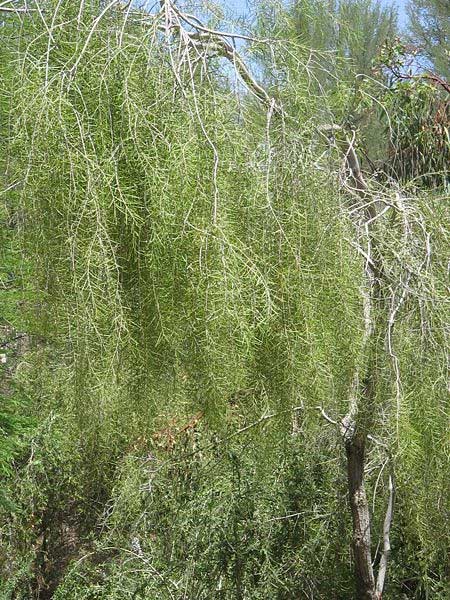
Acacia estrophiolata (Photo: *)
Acacia estrophiolata, commonly known as ironwood,[1] southern ironwood,[2] desert ironwood[3] or utjanypa,[4] is a tree native to Central Australia.
Description
It is a graceful, pendulous shade tree, which grows from about 4 to 16 metres (13 to 52 ft) tall[5] and has a trunk with a diameter of up to about 0.45 m.[6] It has a spreading crown that becomes weeping as the tree matures.[1] Young plants have rigid branches and short straight phyllodes that appear in clusters as trees mature the branches become pendulous and the light green spiky phyllodes in crease in length but are no longer clustered.[1] It has a heavy bloom of spherical pale yellow flowers after winter rains.
The tree has a slow growth rate and is both drought and frost tolerant.[1]
Taxonomy
The species was first formally described by botanist Ferdinand von Mueller in 1882 as part of the work Definitions of some new Australian plants as published in Southern Science Record. It was reclassified as Racosperma estrophiolatum by Leslie Pedley in 1987 then returned to the genus Acacia in 2001.[2]
It is closely related to Acacia excelsa and more distantly related to Acacia dolichophylla.[5]
The type specimen was collected near the Finke River in the Northern Territory by H.Kempe.[5]
Distribution
The tree is found in north western parts of South Australia,[4] southern parts of the Northern Territory and eastern parts of the Pilbara and Goldfields regions of Western Australia.[3]
It is usually found in areas with about 220–350 mm/year of average rainfall.[6]
Classification System: APG IV
Superregnum: Eukaryota
Regnum: Plantae
Cladus: Angiosperms
Cladus: Eudicots
Cladus: Core eudicots
Cladus: Rosids
Cladus: Eurosids I
Ordo: Fabales
Familia: Fabaceae
Subfamilia: Caesalpinioideae
Tribus: Acacieae
Genus: Acacia
Species: Acacia estrophiolata
Name
Acacia estrophiolata F.Muell., 1882
Synonyms
Racosperma estrophiolatum (F.Muell.) Pedley
Distribution
Native distribution areas:
Acacia estrophiolata
Continental: Australasia
Regional: Australia
Northern Territory, South Australia, Western Australia
References: Brummitt, R.K. 2001. TDWG – World Geographical Scheme for Recording Plant Distributions, 2nd Edition
References
Primary references
Mueller, F.J.H. v., 1882. Southern Science Record. Melbourne 2:150.
Links
Govaerts, R. et al. 2020. Acacia estrophiolata in Kew Science Plants of the World online. The Board of Trustees of the Royal Botanic Gardens, Kew. Published online. Accessed: 2020 Aug 02. Reference page.
International Plant Names Index. 2019. Acacia estrophiolata. Published online. Accessed: Aug 02 2019.
Tropicos.org 2019. Acacia estrophiolata. Missouri Botanical Garden. Published online. Accessed: 02 Aug 2019.
Hassler, M. Aug. Acacia estrophiolata. World Plants: Synonymic Checklists of the Vascular Plants of the World In: Roskovh, Y., Abucay, L., Orrell, T., Nicolson, D., Bailly, N., Kirk, P., Bourgoin, T., DeWalt, R.E., Decock, W., De Wever, A., Nieukerken, E. van, Zarucchi, J. & Penev, L., eds. Aug. Species 2000 & ITIS Catalogue of Life. Published online. Accessed: Aug 02 {{{3}}}. Reference page.
USDA, ARS, Germplasm Resources Information Network. Acacia estrophiolata in the Germplasm Resources Information Network (GRIN), U.S. Department of Agriculture Agricultural Research Service. Accessed: 09-Oct-10.
Vernacular names
English: Southern Ironwood
A. estrophiolata grows mostly on sandy alluvial flats in sandy well drained soils, found as scattered trees among tall open shrubland and open woodland communities.[5]
Uses
Food
Traditionally, Australian Aborigines would use the gum from the tree as a sweet bushtucker treat. Its name in the Arrernte language of Central Australia is Ngkwarle athenge arlperle. It is still sometimes eaten today.
Acacia estrophiolata Bark
The gum is snapped off the branches, either clear or red. It is then ground and mixed with a little water, then left to set again to a chewable gum, and eaten with a small stick.
Forage
The tree makes good forage for livestock.[6] The seeds are edible and are 28.9% protein.[7]
Acacia estrophiolata Foliage
Traditional medicine
Parts of the tree are used topically to treat skin problems such as burns, cuts, scabies, sores and it is also used for treating major wounds. It is used as a lotion to treat eye problems.[8][9]
Wood
The wood is very hard and it is good for making posts for fences.[6] It is used by indigenous Australians to make spears and arrows.[10]
See also
List of Acacia species
References
"Acacia estrophiolata Ironwood" (PDF). Arid Zone Trees. Retrieved 13 September 2018.
"Acacia estrophiolata F.Muell. Southern Ironwood". Atlas of Living Australia. Global Biodiversity Information Facility. Retrieved 13 September 2018.
"Acacia estrophiolata". FloraBase. Western Australian Government Department of Biodiversity, Conservation and Attractions.
"Acacia estrophiolata (Leguminosae) Utjanypa". Seeds of South Australia. Government of South Australia. Retrieved 13 September 2018.
"Acacia estrophiolata". WorldWideWattle. CSIRO. Retrieved 13 September 2018.
"Acacia estrophiolata F. Muell". FAO. 9 July 2008. Archived from the original on 9 July 2008.
"Food Standards Australia New Zealand". 2007. Archived from the original on 2007-09-14. Retrieved 2007-05-25.
Dr.Fish. "Traditional Aboriginal medicine practices in the Northern Territory" (PDF). Government of Northern Territory. Archived from the original (PDF) on 2007-09-08. Retrieved 7 September 2007.
"Archived copy" (PDF). Archived from the original (PDF) on 2007-09-08. Retrieved 2007-05-25.
"Sunshine Wattle (German)". Retrieved 7 September 2018.
Retrieved from "http://en.wikipedia.org/"
All text is available under the terms of the GNU Free Documentation License

